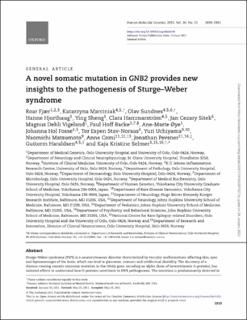| dc.contributor.author | Fjær, Roar | |
| dc.contributor.author | Marciniak, Katarzyna | |
| dc.contributor.author | Sundnes, Olav | |
| dc.contributor.author | Hjorthaug, Hanne | |
| dc.contributor.author | Sheng, Ying | |
| dc.contributor.author | Hammarström, Clara Louise | |
| dc.contributor.author | Sitek, Jan Cezary | |
| dc.contributor.author | Vigeland, Magnus Dehli | |
| dc.contributor.author | Backe, Paul Hoff | |
| dc.contributor.author | Øye, Ane-Marte | |
| dc.contributor.author | Hol, Johanna | |
| dc.contributor.author | Stav-Noraas, Tor Espen | |
| dc.contributor.author | Uchiyama, Yuri | |
| dc.contributor.author | Matsumoto, Naomichi | |
| dc.contributor.author | Comi, Anne | |
| dc.contributor.author | Pevsner, Jonathan | |
| dc.contributor.author | Haraldsen, Guttorm | |
| dc.contributor.author | Selmer, Kaja Kristine | |
| dc.date.accessioned | 2023-01-13T15:03:32Z | |
| dc.date.available | 2023-01-13T15:03:32Z | |
| dc.date.created | 2021-12-02T11:39:08Z | |
| dc.date.issued | 2021 | |
| dc.identifier.citation | Human Molecular Genetics. 2021, 30 (21), 1919-1931. | en_US |
| dc.identifier.issn | 0964-6906 | |
| dc.identifier.uri | https://hdl.handle.net/11250/3043463 | |
| dc.description.abstract | Sturge–Weber syndrome (SWS) is a neurocutaneous disorder characterized by vascular malformations affecting skin, eyes and leptomeninges of the brain, which can lead to glaucoma, seizures and intellectual disability. The discovery of a disease-causing somatic missense mutation in the GNAQ gene, encoding an alpha chain of heterotrimeric G-proteins, has initiated efforts to understand how G-proteins contribute to SWS pathogenesis. The mutation is predominantly detected in endothelial cells and is currently believed to affect downstream MAPK signalling. In this study of six Norwegian patients with classical SWS, we aimed to identify somatic mutations through deep sequencing of DNA from skin biopsies. Surprisingly, one patient was negative for the GNAQ mutation, but instead harbored a somatic mutation in GNB2 (NM_005273.3:c.232A>G, p.Lys78Glu), which encodes a beta chain of the same G-protein complex. The positions of the mutant amino acids in the G-protein are essential for complex reassembly. Therefore, failure of reassembly and continuous signalling is a likely consequence of both mutations. Ectopic expression of mutant proteins in endothelial cells revealed that expression of either mutant reduced cellular proliferation, yet regulated MAPK signalling differently, suggesting that dysregulated MAPK signalling cannot fully explain the SWS phenotype. Instead, both mutants reduced synthesis of Yes-associated protein (YAP), a transcriptional co-activator of the Hippo signalling pathway, suggesting a key role for this pathway in the vascular pathogenesis of SWS. The discovery of the GNB2 mutation sheds novel light on the pathogenesis of SWS and suggests that future research on targets of treatment should be directed towards the YAP, rather than the MAPK, signalling pathway. | en_US |
| dc.language.iso | eng | en_US |
| dc.publisher | Oxford University Press | en_US |
| dc.rights | Navngivelse 4.0 Internasjonal | * |
| dc.rights.uri | http://creativecommons.org/licenses/by/4.0/deed.no | * |
| dc.title | A novel somatic mutation in GNB2 provides new insights to the pathogenesis of Sturge-Weber syndrome | en_US |
| dc.type | Peer reviewed | en_US |
| dc.type | Journal article | en_US |
| dc.description.version | publishedVersion | en_US |
| dc.source.pagenumber | 1919-1931 | en_US |
| dc.source.volume | 30 | en_US |
| dc.source.journal | Human Molecular Genetics | en_US |
| dc.source.issue | 21 | en_US |
| dc.identifier.doi | 10.1093/hmg/ddab144 | |
| dc.identifier.cristin | 1963312 | |
| dc.relation.project | Helse Sør-Øst RHF: 2015095 | en_US |
| dc.relation.project | Helse Sør-Øst RHF: 2014018 | en_US |
| dc.relation.project | Helse Sør-Øst RHF: 2012066 | en_US |
| dc.relation.project | Norges forskningsråd: 214867 | en_US |
| cristin.ispublished | true | |
| cristin.fulltext | original | |
| cristin.qualitycode | 2 | |

